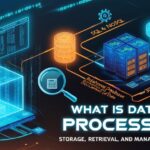In today’s digital world, data is at the heart of every decision, application, and system. Whether it’s a small business tracking customer orders or a large corporation managing global supply chains, the efficient handling of data is critical. This is where database processing comes in. But what exactly is database processing, and why is it so essential in modern computing?
In this article, we’ll look at database processing. We’ll discuss how it works, its types, and its benefits. We’ll also cover applications and common challenges businesses face.
Understanding Database Processing
Database processing means storing, managing, retrieving, and manipulating data in a database in an organized way. This is done using a Database Management System (DBMS). It allows users and applications to interact with large volumes of data in a structured and organized way.
A DBMS connects users to data. It offers tools for entering data, running queries, and showing results.
Key Components of Database Processing
- Data: The actual pieces of information stored.
- Database: A structured collection of related data.
- DBMS: The software used to manage and interact with the database.
- Users: Individuals or systems that use the database.
How Does Database Processing Work?
The process begins when a user or application submits a request—often in the form of a Structured Query Language (SQL) command. The DBMS reads the command, gets the data from the database, and sends back the results. Here’s a simplified step-by-step:
- Data Entry: Information is input via forms, scripts, or applications.
- Query Execution: SQL statements such as SELECT, INSERT, UPDATE, or DELETE are run.
- Data Processing: The DBMS handles the request using indexing, caching, and optimization techniques.
- Output Results: The processed data is displayed or passed back to the requesting system.
Types of Database Processing
Understanding the types of database processing helps you choose the best method for your needs. Here are the three primary types:
1. Batch Processing
In batch processing, data is collected over time and processed in one go. This is common for payroll systems, monthly billing, or reporting tasks. It’s efficient but not suitable for real-time decision-making.
2. Real-Time Processing
Real-time processing occurs instantly as data is entered. It’s used in systems where quick info matters. This includes online transactions, flight bookings, and stock trading platforms.
3. Distributed Processing
Distributed database processing involves storing and processing data across multiple locations or servers. This improves performance, scalability, and data availability. It’s especially true for big applications like social media or cloud services.
Benefits of Database Processing
Using database processing offers numerous advantages for individuals, developers, and organizations alike. Below are the top benefits:
1. Data Organization
Well-structured tables, fields, and relationships help organize information logically. This makes database processing clear and easy to access.
2. Data Integrity
Through constraints, primary keys, and validation rules, databases ensure data consistency and accuracy.
3. Data Security
Modern DBMS platforms have features that protect sensitive data. They include encryption, access control, and user authentication.
4. Multi-User Access
Many users can access and change the data at the same time. This is important for teamwork.
5. Efficiency and Speed
Indexing and query optimization help databases work quickly. They ensure fast retrieval and updates, even with large datasets.
Common Uses of Database Processing
Database processing is everywhere—from apps on your smartphone to enterprise-level software. Below are some everyday applications:
E-commerce Platforms
Online stores use databases to manage product listings, customer profiles, and order history.
Healthcare Systems
Hospitals and clinics use databases to store patient records, lab results, and treatment histories securely.
Educational Institutions
Schools and universities manage enrollment, attendance, grading, and more using database systems.
Financial Services
Banks use database processing for transactions, loan management, account histories, and compliance reporting.
Popular Database Management Systems
If you’re starting with database processing, you’ll probably come across these popular DBMS platforms:
- MySQL: Open-source and widely used for web applications.
- PostgreSQL: Known for advanced features and standards compliance.
- Microsoft SQL Server: Enterprise-grade solution by Microsoft.
- Oracle Database: Powerful and scalable solution for large enterprises.
- MongoDB: A NoSQL option ideal for handling unstructured data.
Each system has unique use cases. However, they all focus on making database processing efficient and easy for users.
Challenges in Database Processing
While database processing is powerful, it’s not without its hurdles. Here are some of the common issues users and developers face:
Data Volume
As businesses grow, the sheer amount of data can overwhelm traditional databases. This calls for scalable solutions like distributed databases or cloud-based DBMS.
Complexity
Creating and managing a relational database can be tricky and take a lot of time. Normalization and optimized indexing add to this complexity.
Security Risks
Databases need proper setups and monitoring. Without them, they can face breaches, SQL injection attacks, and data leaks.
Cost of Maintenance
Database licenses, storage requirements, and skilled staff can lead to high operational costs.
The Future of Database Processing
With the rise of big data, AI, and cloud computing, database processing continues to evolve. Here are some trends shaping its future:
Cloud-Based Databases
Services like Amazon RDS, Google Cloud SQL, and Microsoft Azure SQL help you manage databases easily. You don’t need physical infrastructure.
AI Integration
AI tools now integrate with DBMS platforms. They help with predictive analytics, spot anomalies, and optimize processes automatically.
NoSQL and NewSQL
Alternative models like document, graph, and key-value databases offer flexibility for non-relational data.
Conclusion
Database processing is key to managing and using data in our digital world. Efficient database processing is crucial. It helps organize large information stores and powers real-time applications.
If you’re a developer creating an app or a business owner seeking better data flow, understanding database processing can help you make smarter, scalable choices. As technology advances, mastering this area opens up new opportunities in data management, automation, and digital transformation.
Frequently Asked Questions (FAQs)
1. What is database processing?
Database processing is how we store, retrieve, and manage data with a Database Management System (DBMS). It enables users and applications to access and manipulate structured data efficiently.
2. Why is database processing important? Database processing is crucial for organizing, securing, and analyzing large amounts of data. It supports accurate decision-making, enhances data accessibility, and ensures consistency across digital systems.
3. What is a Database Management System (DBMS)?
A DBMS is software that allows users to interact with databases. It offers tools to enter, update, search, and manage data. It also keeps data secure and maintains its integrity.
4. What are examples of database processing in daily life?
Common examples are:
- Online shopping platforms that manage inventory.
- Banks that process transactions.
- Hospitals that store patient records.
- Schools that track student information.
5. What types of database processing are there? There are three main types:
- Batch Processing: Processes large volumes of data in groups.
- Real-Time Processing: Handles data immediately as it’s entered.
- Distributed Processing: Uses multiple systems to process and manage data across different locations.
6. What is the difference between a database and database processing?
A database is a structured way to store data. Database processing includes operations like inputting, updating, and retrieving information.
7. What is SQL in database processing?
SQL (Structured Query Language) is the standard language used to communicate with databases. It helps with tasks like inserting data, querying it, updating records, and deleting entries.
8. What are the benefits of using database processing?
Key benefits include:
- Improved data organization
- Fast and accurate information retrieval
- Enhanced security and access control
- Multi-user support
- Scalable data management
9. Can small businesses benefit from database processing?
Yes. Small businesses can use simple databases. They help manage customer data, sales, inventory, and employee information. This makes operations more efficient and reduces errors.
10. What is the role of indexing in database processing?
Indexing boosts data retrieval. It helps the DBMS find data quickly. It’s similar to how a book index helps you find topics fast.
11. Is database processing only for structured data?
Traditional databases work with structured data. Modern systems, like NoSQL databases, can also handle semi-structured and unstructured data.
12. What are some popular database management systems?
Popular DBMS platforms include:
- MySQL
- PostgreSQL
- Oracle Database
- Microsoft SQL Server
- MongoDB (for NoSQL use cases)










